By Rubrik Public Sector Chief Technology Officer Travis Rosiek
Without a robust, compliant, and effects-based cybersecurity program, an organization cannot expect to manage its data and privacy requirements and enforce effective privacy controls on data. Unfortunately, the current landscape paints a grim picture: a growing attack surface, intricate networks of complex systems and supply chains, escalating cybercriminal activity and innovation, and a staggering 3.4 million-person global shortage in the cybersecurity workforce. Due to the increased complexity and insufficient availability of human expertise, harnessing AI may be the only option.
In the future, I believe AI will better analyze code to help detect exploitable vulnerabilities that traverse an ever-growing code base for most applications. Another advantage of AI is that it can help developers write more secure code by giving suggestions or even writing parts of it. Lastly, AI will help emulate user interaction with code to help test edge cases with inputs, ultimately reducing vulnerabilities of code in the wild.
It will take time to build guardrails, fail-safes, and security to effectively monitor the accuracy of AI systems and ensure they perform as expected. Additionally, certain use cases will require human involvement in the decision-making loop to provide safe and trustworthy implementation and avoid adverse impacts on individuals’ health and safety. These include when AI is not performing as expected and inaccurately detecting medical treatments or diagnoses, physical threats, natural disasters, navigation, or missed cybersecurity attacks and mitigation.
 About the author:
About the author:
Travis Rosiek is Public Sector Chief Technology Officer at Rubrik. In his role, he helps organizations become more cyber and data resilient with his over 20 years of experience in the public and private sector.

